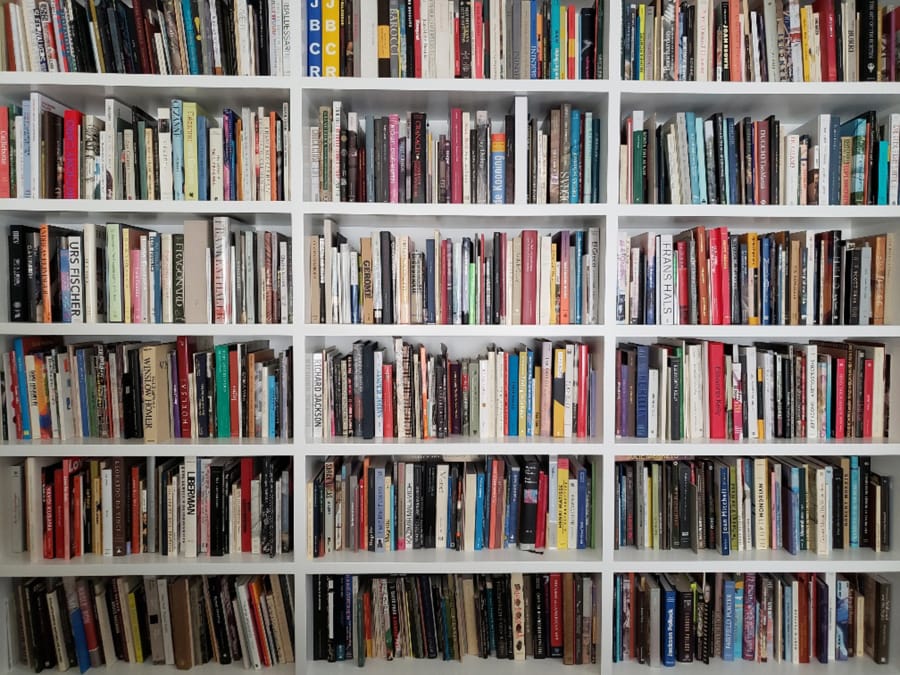In my home library, “De Chirico,” the slim but invaluable catalog to the Museum of Modern Art’s marvelous 1982 survey of the perplexing Italian metaphysical painter Giorgio de Chirico (1888-1978), had been shelved upside down.
I wasn’t surprised. My art-book library is not disorganized, but neither is it as shipshape as it should be.
When I pulled the catalog down to turn it right side up, I wondered for a moment: Should I leave the book filed here, right between Spain’s Eduardo Chillida and Bulgarian American Christo, with the artists whose names begin with C? The single-artist monographs that make up the lion’s share of my library, whether catalogs, biographies or art history books, are lined up in basic alphabetical order.
Or, should De Chirico be shelved under D, the way the four books on Jay DeFeo and the five on Willem De Kooning are?
Nobody refers to those two artists as just Feo or Kooning, I reasoned, but often the Italian artist is just called Chirico. So, I decided to leave the catalog shelved under C.
Multiply that pause a couple hundred times over, however, and the reason becomes clear why I had procrastinated on the task of straightening up my art library — which numbers more than 2,000 books. More than two years ago I moved, and during all the packing and unpacking the filing system had occasionally gotten jumbled.
Now, with the novel coronavirus pandemic having shut down art museums and galleries, I had an opening. With cautions for social distancing keeping me at home more than usual, fixing the shelving glitches seemed a productive way to spend the time.
I did not expect that it would be fun. Turned out stumbling on favored if forgotten art books has its rewards.
Of all the onerous aspects of closing out one house and moving to another, none had been less pleasant than moving my library. The professional movers could pretty much disassemble the kitchen and cart out the furniture on their own. But the books? Not the books.
That required unusual prep. Alphabetical order had to be maintained — by artist for the monographs and by author for the books of criticism. Histories are grouped by geography and period, depending on the book’s subject, and on occasion by art medium.
In the process of packing, I set a couple hundred books aside, thinning the herd. Those I gave away.
Labeled and numbered moving boxes were prepared but there was no way to keep the order of books exact inside each box. Some books fit, some didn’t, and the movers had a job to get done.
At the other end of the move, labeled boxes were divided up among the three different rooms where shelves had been built — “A” through the start of “R” in one, the rest of “R” through “Z” in another, all the remainder in a third. A helpful friend unpacked and placed books in whatever order they came out of the boxes.
Most of it worked pretty well, but a chunk of it did not. I put off the fixes for years.
What surprised me when I started going through the shelves the other day was that it turned out to be not the least bit unpleasant. I had really admired that MoMA De Chirico show, for instance, but I hadn’t cracked that catalog in decades. Doing it now brought me back.
I went into a file cabinet to dig out what I had written about De Chirico’s cityscapes. Most of the review seemed just fine. Then, flipping through the book, my eye snagged on a couple of picture-pages.
Plazas are nearly empty, long corridors of Roman arches are blank, sharp perspective lines don’t quite match up, which sends the ground plane tilting up and down. Steep shadows cast by a late afternoon sun, forbidding fortress towers, the Vatican’s famously uncomfortable sculpture of sleeping Ariadne from ancient Greek myth — the images were familiar. The years leading up to the nightmarish catastrophe of World War I are hauntingly evoked.
Rummaging through bookshelves is a different experience from searching online. Both court serendipity. But the accident of a book, perhaps because it is a physical object rather than the glowing ephemera of digital pixels, is of another order. It has a singular density and weight.



